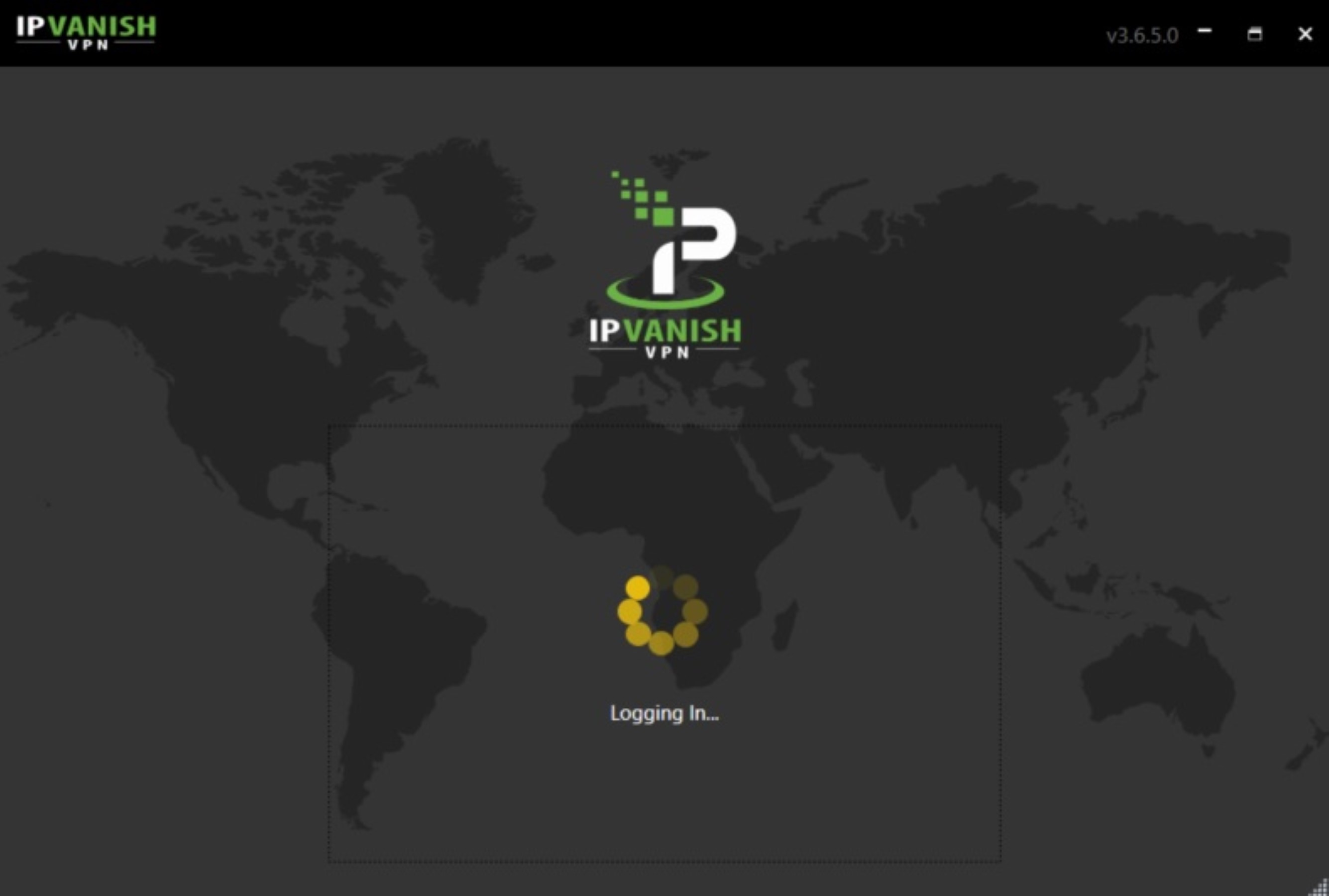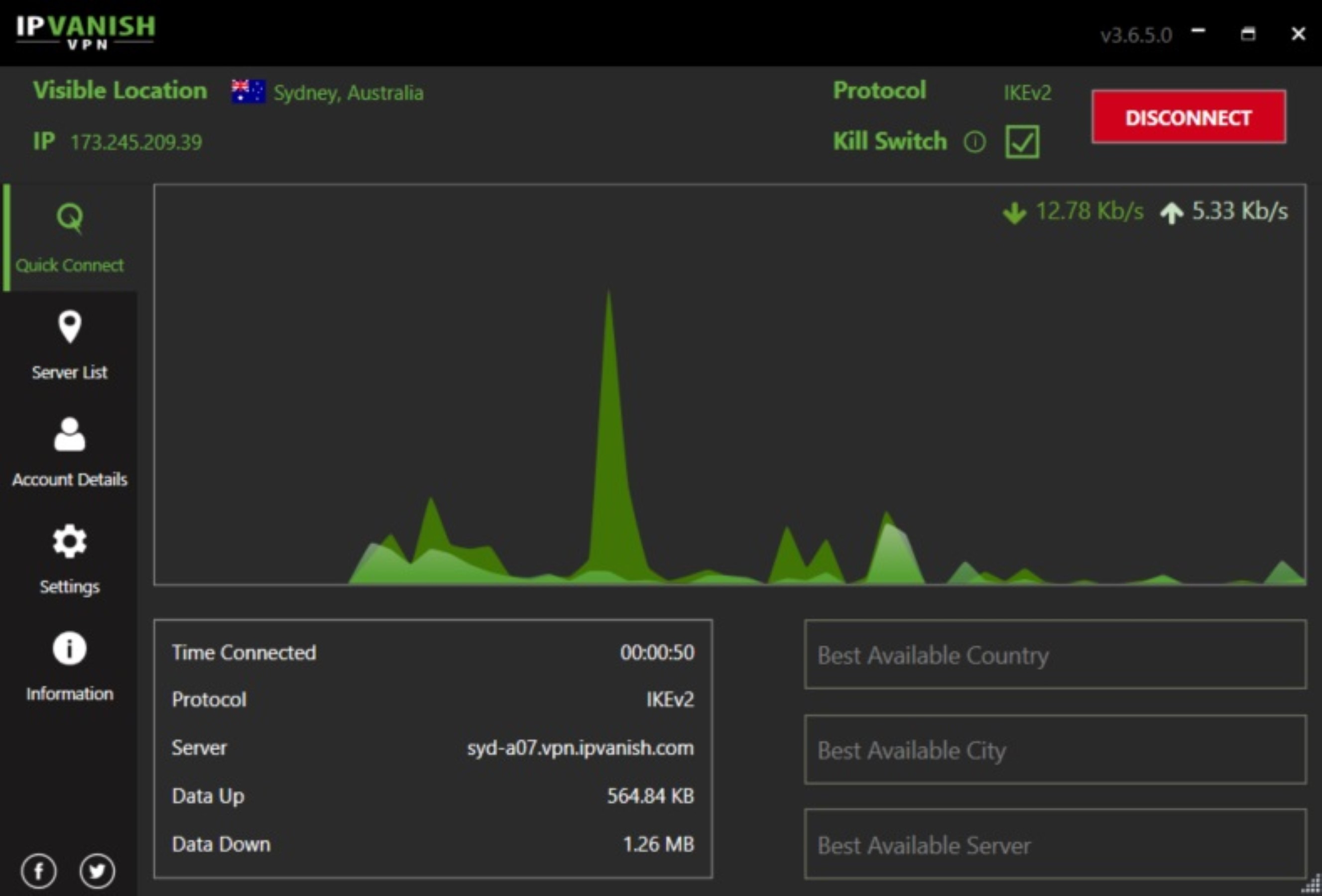For comparison, the pricing table below pits IPVanish against our current top five VPN providers. During my initial tests, IPVanish only took a few seconds to connect, but that stretches to up to 15 seconds when you start to manually tinker with the servers. Disconnecting only takes a couple of seconds, but the connection/disconnection is slow enough to pause disruption-sensitive online services like music streaming (for a few seconds). Click the ‘Connect’ button and, by default, IPVanish connects to the best available country, city, and server. For me, this meant connecting to a Sydney server, which is what you’d expect. You can tweak this, though, to connect to a specific country, city, or server. IPVanish won’t let you switch these quick-connect options when you’re connected to a VPN server, but you can manually connect to another country or city from the server list. Strangely, that final ‘server’ option in the quick-connect list is where you can manually connect servers, but they don’t have any meaningful indicators of location or latency to help you pick the best one. This is at odds with the option to filter servers by latency (even if latency understandably gets noticeably worse when you step outside of Oceania). The kill switch is off by default but can be enabled from the front page or within the connection settings, but note that a kill switch stops all internet activity whenever IPVanish is not connected. In terms of servers, IPVanish has 2,000+ servers in more than 75 locations which, by my count, amounted to 52 countries at the time of updating this review. IPVanish lets you track its server count here, which breaks down into the following:
1,314 in North America 533 in Europe 90 in Asia 73 in Oceania 31 in South America 11 in Africa
For comparison, IPVanish has the lowest global server count of the eight VPN reviews that I’ve updated so far and its country count of 52 is the second lowest (‘beaten’ only by Norton Secure’s 31). This is likely why IPVanish spruiks its 40,000+ IP addresses over those other two numbers, which is something that other VPN providers don’t tend to advertise. You can see the IPVanish VPN supported devices below:
Windows 8.1 and 10 MacOS 10.11 and up iOS 11.0 and up Android 5.0 and up (stable version) Linux (Debian or RedHat) DD-WRT v2 and v3, Tomato, Asus-WRT and Merlin routers Fire TV Chrome OS
Helpfully, IPVanish offers guides for all of these platforms, even if device setup was incredibly straightforward in my Windows and Android tests. Note that installing IPVanish or any other VPN on a compatible router means all devices in your home network will effectively use the VPN whenever it’s connected. The table below uses my Superloop NBN 100/40Mbps Fibre-to-the-Curb home internet to give you an idea of how IPVanish performs during the middle of the day, relative to my internet speeds with the VPN disconnected. When I manually connected to a Los Angeles server, the speeds got measurably worse, so you’re better off sticking with what IPVanish recommends for the best speeds. Things were even more dire for connecting to the UK, with differences starting at 80% and getting worse. Those abroad looking to connect to Australian streaming services like Kayo and Stan also shouldn’t rely on IPVanish. Kayo was blocked from servers in Sydney, Brisbane, Melbourne, and Perth, with a VPN notification after loading the library from an Adelaide server. Stan had mixed results: it worked for Adelaide and Melbourne servers but was blocked with Sydney, Brisbane, and Perth servers. Normally, this is the part of my VPN review here I’d post a table giving an indication of IPVanish’s streaming speeds for popular US and UK streaming services. This paints a picture of how many simultaneous streams you could use taking into account the IPVanish speed changes atop the average NBN typical evening download speeds. But because IPVanish only works with Netflix US, there’s no point. There’s also a split tunneling feature – useful for separating full-speed, unsecured network traffic from slower-speed, encrypted VPN traffic or sidestepping certain geoblocking measures (like those used in Prime Video) – but it’s restricted to Android and Fire TV devices, which is a shame. In terms of privacy peace of mind, IPVanish has a zero-logging policy to preserve anonymity while you’re connected. ExpressVPN and NordVPN have decent server counts at 3,000+ and 5,440, respectively, with servers in 59 (NordVPN) and 94 countries (ExpressVPN). Both of these values easily surpass the 2,000+ servers and 52 countries offered by IPVanish. Where IPVanish pulls ahead is in simultaneous connections: ExpressVPN only has five, NordVPN taps out at six and IPVanish has unlimited. All VPN services offer 24/7 tech support and a 30-day money-back guarantee (albeit IPVanish’s is limited to annual subscriptions only) as well as military-grade encryption and all three have a zero-logging policy. NordVPN and ExpressVPN both have cleaner interfaces that are more user-friendly than IPVanish, and they are also both better at sidestepping the geoblocking measures of international streaming services, plus they offer speedier streaming solutions via an included Smart DNS service. In terms of speeds, NordVPN and ExpressVPN edge out IPVanish with local download (4% and 6% changes vs 7%), but they all have identical latency. All three have identical best-case latency to the US, but NordVPN and ExpressVPN have a lower impact to download speed (14% and 16% vs 19%), while ExpressVPN has the lowest upload variance (19%) compared to the higher scores from IPVanish (43%) and NordVPN (84%) The only real reason you’d consider IPVanish over NordVPN or ExpressVPN is if you want to protect as many devices as possible.

